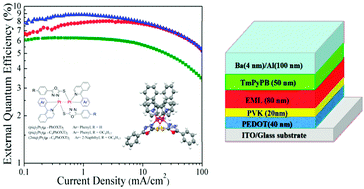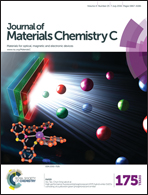Dinuclear platinum complexes containing aryl-isoquinoline and oxadiazole-thiol with an efficiency of over 8.8%: in-depth investigation of the relationship between their molecular structure and near-infrared electroluminescent properties in PLEDs†
Abstract
Two novel dinuclear platinum complexes of (2niq)2Pt2(μ-C8PhOXT)2 and (piq)2Pt2(μ-PhOXT)2 were synthesized and characterized, where 2niq is 2-naphthyl-isoquinolinate, piq is 1-pheny-isoquinolinate, and μ-C8PhOXT and μ-PhOXT are anions of 5-(4-octylphenyl)-1,3,4-oxadiazole-2-thiol and 5-phenyl-1,3,4-oxadiazole-2-thiol, respectively. The Pt–Pt bond was confirmed by the (piq)2Pt2(μ-PhOXT)2 single crystal. A high-efficiency NIR electroluminescence peak at about 704 nm was observed for this (2niq)2Pt2(μ-C8PhOXT)2 in the solution-processed PLEDs with a notable external quantum efficiency (EQE) of 8.86% and an irradiate of 986 μW cm−2 at 9 wt% dopant concentration. Moreover, the efficiency roll-off was efficiently restrained, with an EQE of 5.22% at a current density of 100 mA cm−2 and 8.47% at 12 wt% dopant concentration.


 Please wait while we load your content...
Please wait while we load your content...